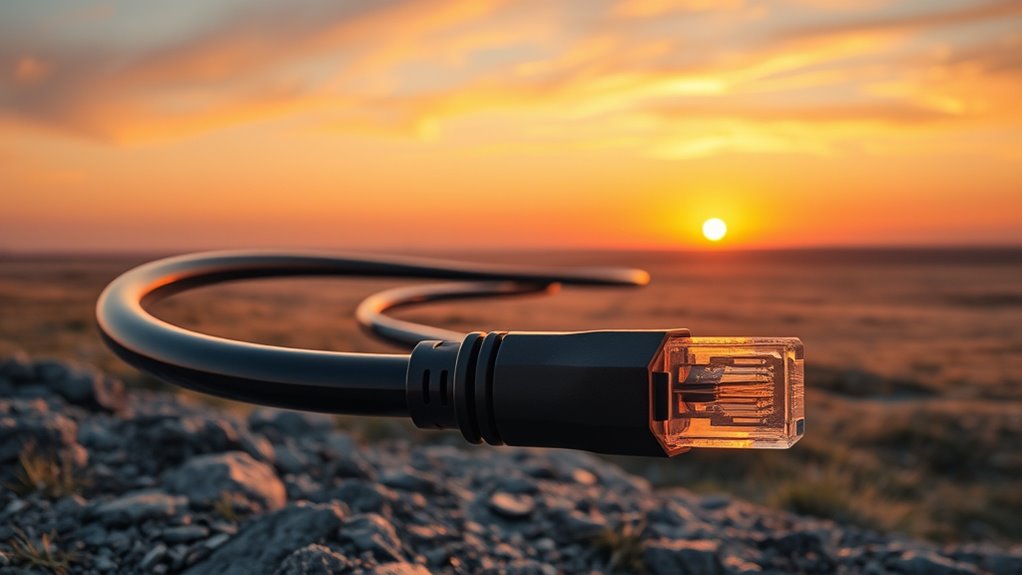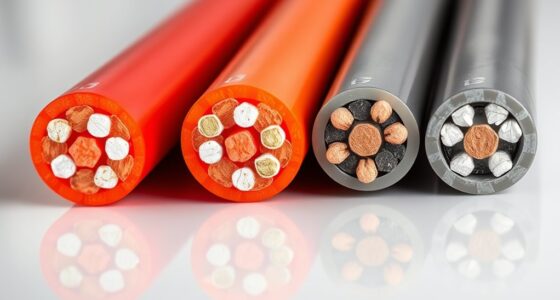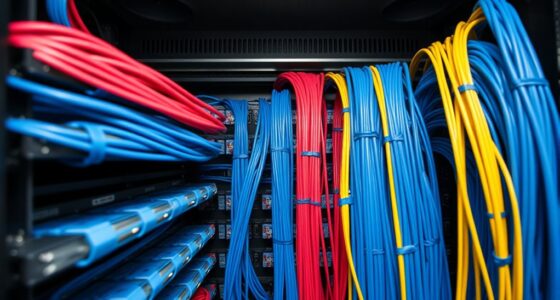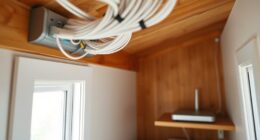Extending Ethernet connections over long distances can be more complex than it seems, especially when considering signal limitations and cable quality. While a typical copper cable might only reach about 100 meters before losing integrity, there are solutions that can help you go further. Understanding these options is vital for maintaining reliable, high-speed networks across large areas or outdoor environments. Curious about the best methods to keep your Ethernet signals strong over miles?
Key Takeaways
- Use fiber optic cables to transmit Ethernet signals over long distances with minimal signal loss.
- Install signal repeaters or regenerators at intervals to boost weakened signals.
- Consider Ethernet extenders or media converters for extending copper cable ranges effectively.
- Implement powered switches or optical network terminals to maintain high-speed connectivity.
- Choose appropriate equipment based on distance, environment, and required bandwidth for reliable performance.
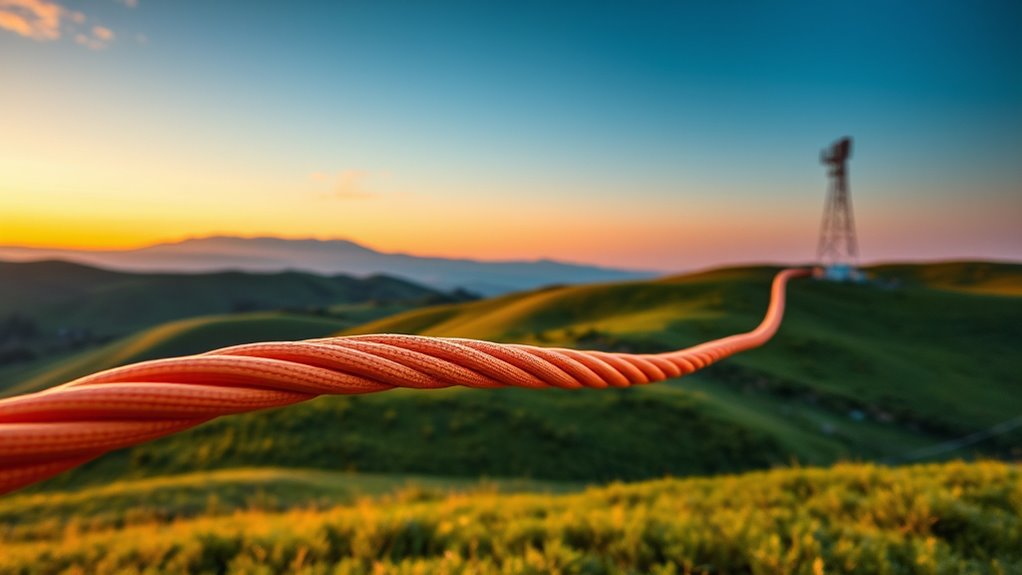
Running Ethernet over long distances can be challenging, but with the right solutions, you can maintain reliable high-speed connections far beyond typical cable limits. When Ethernet cables stretch over hundreds or even thousands of feet, signal degradation becomes a real concern. Copper cables like Cat6 or Cat5e are limited in length, usually around 100 meters, before the signal weakens and data transfer speeds drop. To overcome this, many network professionals turn to fiber optics, which can transmit data over much longer distances without significant loss. Fiber optic cables use light signals instead of electrical pulses, allowing for high-speed, high-bandwidth connections over miles with minimal signal degradation.
Ethernet signals weaken over long distances, but fiber optics and repeaters keep connections fast and reliable.
However, deploying fiber optics isn’t always straightforward or cost-effective for every situation. That’s where signal repeaters come into play. Signal repeaters act as amplifiers or regenerators, boosting the weakened signal to its original strength so that it can continue traveling over long distances. When you install a signal repeater at strategic points along your Ethernet run, you essentially extend the reach of your network. This is especially useful in large buildings, campuses, or outdoor environments where running a single cable over long distances isn’t feasible. Signal repeaters are simple in concept but powerful in function, ensuring your data remains intact and your connection stays fast.
Using fiber optics combined with signal repeaters offers a robust solution for long-distance Ethernet transmission. You might run fiber optic cables from your main network hub to a remote building or a different part of your property. At certain intervals, especially if the distance is very long, you can place signal repeaters to regenerate the signal, ensuring data integrity and high speeds. This setup minimizes latency and prevents data loss, which are critical for applications like streaming, real-time communication, or data-intensive tasks. Fiber optics also provide immunity to electromagnetic interference, so your connection remains stable even in electrically noisy environments.
Choosing the right equipment depends on your specific needs and distance. For shorter runs, fiber optics alone might suffice. For longer stretches, adding signal repeaters ensures your network remains reliable. Combining these technologies saves you from the frustrations of slow speeds, dropped connections, or costly rewiring later. With fiber optics and signal repeaters, you’re equipped to extend your Ethernet network further than ever before, maintaining fast, stable, and efficient connectivity across vast distances.
Frequently Asked Questions
What Are the Cost Differences Between Various Long-Distance Ethernet Solutions?
You’ll find fiber optic solutions tend to be more expensive upfront but offer higher speeds and longer distances with lower maintenance costs. Wireless transmission options are cheaper initially and flexible but may face interference and limited range. Costs vary based on distance, required bandwidth, and environment, so you should weigh these factors against your budget and performance needs to choose the most cost-effective long-distance Ethernet solution for your setup.
How Does Environmental Interference Affect Ethernet Signal Quality Over Long Runs?
Imagine a clear stream suddenly disrupted by floating debris—you’ll see how electromagnetic interference and physical obstructions can distort your Ethernet signal. These interferences, like nearby electrical devices or metal objects, weaken data integrity over long runs. Physical obstructions, such as walls or pipes, act like barriers, causing signal attenuation. To guarantee quality, you need shielded cables or repeaters, protecting your network from environmental interference and maintaining a strong, reliable connection.
Can Existing Infrastructure Support Ethernet Over Long Distances Without Upgrades?
Your existing infrastructure may support Ethernet over long distances if it includes fiber optics, which can handle extended ranges without significant signal loss. However, if you’re relying on traditional copper cables, upgrades might be necessary. Wireless alternatives like Wi-Fi or LTE can also provide long-distance connectivity, but they might face interference issues. Assess your current setup to determine if it can accommodate fiber optics or if you should consider wireless options for better coverage.
What Are the Best Practices for Maintaining Signal Integrity Over Extended Runs?
To maintain signal integrity over extended Ethernet runs, you should use shielded cables to reduce interference and prevent signal degradation. Additionally, placing signal repeaters or Ethernet extenders at strategic points helps boost the signal, ensuring reliable data transfer. Regularly check and secure cable connections, avoid sharp bends, and keep cables away from electrical interference sources. These best practices help you sustain ideal performance over long distances.
Are There Legal or Regulatory Considerations for Deploying Long-Distance Ethernet Cables?
Deploying long-distance Ethernet cables is like steering a busy road—you need to follow the rules. You should check telecom regulations and licensing requirements to avoid legal pitfalls. Different regions may have specific rules about cable types, installation methods, or proximity to certain areas. Always consult local authorities or a legal expert to guarantee compliance, so your network stays legal and operational without unexpected penalties or delays.
Conclusion
As you navigate the journey of running Ethernet over long distances, think of fiber optics as a gentle river flowing endlessly, carrying your signals smoothly with minimal loss. Signal repeaters act like friendly bridges, guiding the flow across vast landscapes. While copper cables are like narrow streams, selecting the right method guarantees your data reaches its destination safely and reliably. With the right approach, your network can stretch gracefully, like a ribbon unfurling across the horizon.
